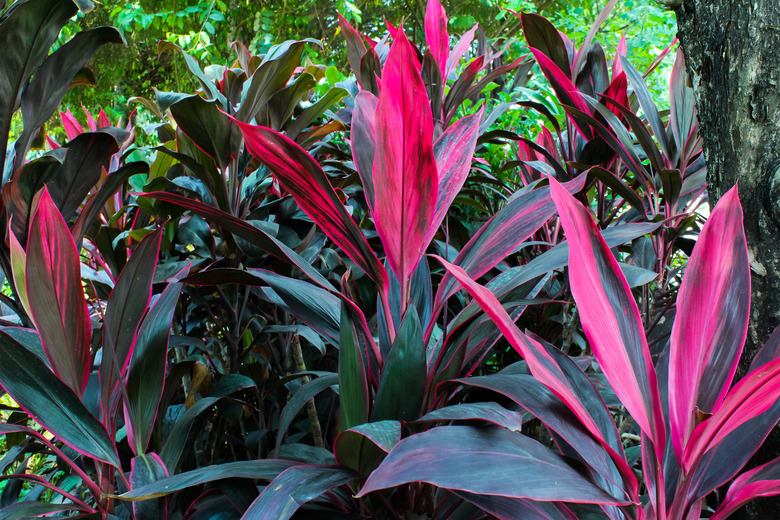How To Transplant A Ti Plant
The ti plant, also called Hawaiian ti plant, cordyline plant and good luck plant, is widely grown as a houseplant in climates colder than USDA zones 10 to 12, where it can grow year round outdoors.
The ti plant (Cordyline fruticosa, synonymous with Cordyline terminalis) has a taproot. Plants with taproots usually transplant poorly, as it is difficult to protect their long, deep root when digging them up. The ti plant is so easily propagated, however, that you could consider creating and planting new plants if you have trouble transplanting an existing ti.
About the Hawaiian Ti Plant
Ti is a tropical plant with colorful foliage valued in Hawaii and other cultures for its ornamental use, particularly in leis and as greenery in floral displays. Hawaiians also use its green leaves to hold taro, pork or fish as they are steamed or roasted. Ti leaves are also used to make hula skirts and as thatch for houses.
Mature plants reach 10 feet high and 4 feet wide, but it is easy to rejuvenate an overgrown ti by pruning it to just 1 foot high because it develops new growth from its primary stem.
Growing Requirements
Ti is natively found in moist locations, such as wet valleys and forests in partial shade. It prefers fertile, deep and well-draining soils with an acidic pH between 5.5 and 6.5. It requires regular irrigation, which is unsurprising given that its native environment is in areas of high rainfall.
Ti Plant Propagation
Ti plants are low-maintenance plants that are easy to propagate, usually from stem cuttings called canes. In fact, many visitors to Hawaii come home with "ti logs," which are pieces of stem that will sprout when popped into a glass of water.
Ti plants are also propagated by seeds—if you can find them.
Warning
Ti plants are susceptible to fluoride toxicity, so houseplants should be watered with distilled water instead of tap water; otherwise, the leaf tips and margins may turn brown.
Transplanting Ti Plants
It's easier to transplant a ti plant growing in a container than one in the ground. You won't have to dig down and potentially sever the taproot when growing it in a container, whether as an indoor plant or outdoors.
Transplanting Ti as a Houseplant
Growing ti in a container as a houseplant is fairly easy because it has low light requirements. A ti houseplant will flourish indoors if you provide it with indirect light and enough moisture.
When the ti outgrows its pot, transplant it to a larger pot with drainage holes or outside, if your climate permits. When repotting, prepare potting soil that is well-draining, such as a potting mix that contains perlite or vermiculite.
First, water it well and then ease it out of its existing pot, taking care to avoid breaking the taproot, which has probably wrapped itself around a few times inside the pot. Don't try to straighten it out; just loosen the rootball a little and place it in its new pot at the same level it was growing in its previous pot.
Most importantly, water it well. Maintain even moisture while it acclimates to its new environment.
Transplanting Ti in the Landscape
A Hawaiian ti plant that is well-established outdoors is going to be tough to move, but it is a forgiving plant and will probably recover.
If your ti plant is large, start by pruning the roots six months before you plan to move the shrub, ideally in the spring. This entails digging a trench in a circle around the rootball, as described by the Clemson Cooperative Extension. Severing the roots a few months before digging out the plant encourages the plant to produce new roots within a more confined area, helping it recover when it is transplanted.
Tip
Root pruning large plants before transplanting can help them reestablish roots in a confined area.
The day before transplant day, water the ti plant well and prepare the new planting hole, digging it about 6 inches wider and deeper than the ti rootball. On transplant day, prune off dead or undesirable branches and then carefully tie up the remaining branches using twine to get them out of the way.
Again, dig a trench on a circle around the rootball, just outside the root pruning trench. Loosen the soil around the shrub and then use a sharp spade to sever the roots rather than allowing them to break, which could impede the healing process. Rock the plant back and forth to identify remaining roots and cut them, using loppers or a handsaw if they are large. Roll the plant on its side and remove any additional connecting roots.
Tip
Use a tarp to move the ti plant to its new location if it is large and heavy.
Drop the ti plant into its new hole, maintaining the same level as it was in its original hole. Add back the soil, tamp it down, and then water it well.
It may take a few months for your Hawaiian ti plant to reestablish new roots. When you see new growth, you'll know the transplant was successful.
